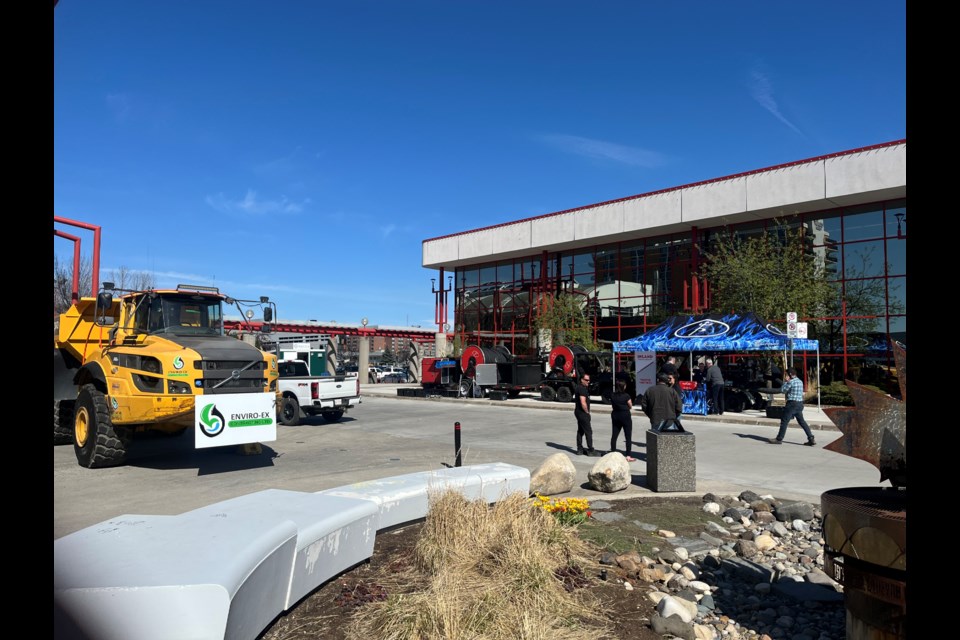More than 550 delegates discussed the future of the northern mining industry at Minerals North 2025 Thursday and Friday.
The Prince George Civic Centre was transformed for the event, with the front filled with mining trucks and equipment, and the interior featuring more than 60 booths.
The conference ran from April 30 to May 2 and featured speakers such as Chief Dolleen Logan of the Lheidli T’enneh First Nation, Prince George Mayor Simon Yu and Jagrup Brar, BC's minister of mining and critical minerals.
“The conference has been amazing this year,” said Sarah Weber, chair of the organizing committee for Minerals North 2025 and CEO of C3 Alliance Corp. “Together with the delegates and students from UNBC, we’re at about 600 participants, which is a high for Minerals North. Because the conference rotates among communities in northern BC, we were so happy to bring it here to Prince George.”
Weber added that she hopes delegates leave with a greater appreciation for the North and its mining opportunities.
“I hope there’s this renewed interest in mining and in moving BC’s mining sector forward,” said Weber. “With all the pressure from down south, there’s a renewed interest, I would say, in the economic contributions that mining can make. BC is well endowed with both critical minerals and precious metals like gold. We have a real opportunity here to help people who may be transitioning out of forestry work into mining and mineral exploration.”
One of the key presentations on the second day of the conference was Investing in the North – Building the Infrastructure & Services. Speakers included Smithers Mayor Gladys Atrill, Terrace Mayor Sean Bujtas and Mayor Yu.
The mayors discussed the critical role mining and its associated infrastructure can play in the growth of northern communities like Prince George.
Bujtas, however, noted challenges his community has faced as a result of mining and energy investment.
“Quite frankly, the cost of industry is being pushed onto the residents,” Bujtas said. “When you think about projects like LNG Canada — I’m very supportive of that project, very supportive of mining and the Golden Triangle. But since the final investment decision for LNG Canada, the City of Terrace has raised its taxes by 40 per cent.
“I don’t know how you would feel, but if you live in the City of Terrace — and you can’t put all that cost onto LNG Canada — why should that project cost you money? Why should it cost your neighbour money? Why should it cost that young mother with small children money?”
The Citizen spoke with Yu following the panel to ask for his thoughts on Bujtas’s comments, and whether the mining industry’s infrastructure could pose challenges for Prince George.
“A lot of times, if you do not grow when industry comes in, then when industry leaves, your population leaves with it,” said Yu. “We need long-term planning in terms of what to do with industry to develop a town, to develop a city.
“A lot of times, industry in a city does evolve, but that requires the city to project a vision. Without that, there’s no synergy. When the industry changes, or when the mine dies out, the population follows it. We want to reverse that. When people come here to work in the mines, we want them to stay here — to raise their families and future generations. Prince George is in a position to make that happen.”
Yu added that he believes Prince George is well positioned to become a key player in the future of mining in the North.
“This will be the place,” said Yu. “Eventually, it will become the centre for all the mining activities in BC, and not just our immediate region, but further — to the Yukon and perhaps the Okanagan.
“Logistically speaking, we’re really at the centre of the province — geographically, historically, and with all the roads and railroads putting us at this spot. Looking at all the exploration happening in all directions, I cannot help but envision that this will be the place. All the workers and their families are going to come here. We’re going to play a pivotal supporting role.”



